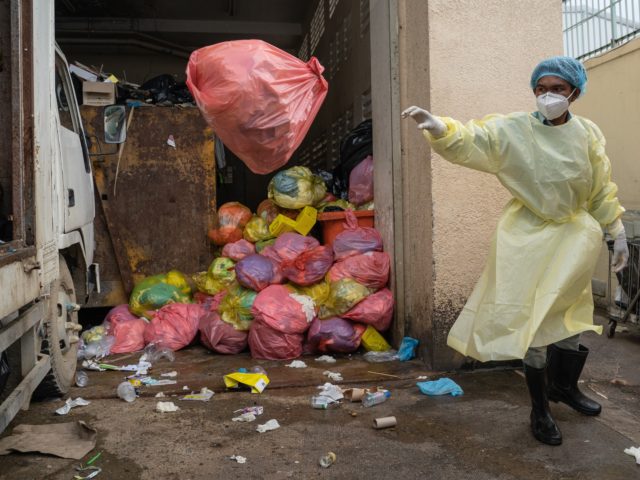Massive amounts of medical waste produced by the Chinese coronavirus pandemic have accumulated worldwide and pose an increasing “threat” to global public health, the World Health Organization (W.H.O.) warned in a report published on Tuesday.
The W.H.O. said on February 1 it estimates to have shipped “87,000 tonnes” of medical equipment to poorer nations in need of Chinese coronavirus health aid from March 2020 to November 2021.
“Most of this equipment is expected to have ended up as waste,” according to the W.H.O., which is the international public health body of the United Nations (U.N.).
A “tonne” is a metric unit of mass equal to 1,000 kilograms or 2,204.6 pounds.
“Tens of thousands of tonnes of extra medical waste from the response to the COVID-19 [Chinese coronavirus] pandemic has put tremendous strain on health care waste management systems around the world, threatening human and environmental health and exposing a dire need to improve waste management practices,” the W.H.O. said Tuesday.
The organization partnered with a U.N. emergency initiative to facilitate international shipments of various medical supplies over the past 20 months including “140 million [coronavirus] test kits, with a potential to generate 2,600 tonnes of non-infectious waste (mainly plastic) and 731,000 litres of chemical waste (equivalent to one-third of an Olympic-size swimming pool).”
The W.H.O. additionally shipped “over 8 billion doses of [coronavirus] vaccine [which] have been administered globally producing 144,000 tonnes of additional waste in the form of syringes, needles, and safety boxes.”

A worker shows discarded personal protective equipment (PPE) found at the Burangkeng landfill where most of the medical waste from Covid-19 hospital wards are collected, in Bekasi on October 19, 2021. (DASRIL ROSZANDI/AFP via Getty Images)
The W.H.O.’s report detailed how 30 percent of healthcare facilities globally — 60 percent in the least developed nations — are “not equipped” to handle medical waste loads. This statistic accounts only for medical waste documented before the onset of the Chinese coronavirus pandemic, which began on March 11, 2020, and remains ongoing today.
Health clinics and hospitals that fail to handle or dispose of medical waste properly risk exposing their employees and patients to “needle stick injuries, burns and pathogenic microorganisms,” according to the W.H.O.
These ill-equipped sites also negatively impact the members of nearby communities by promoting the existence of “poorly managed landfills and waste disposal sites … [which in turn produce] contaminated air from burning waste, poor water quality or disease carrying pests.”
The W.H.O.’s February 1 report recommended some practical solutions to solving the medical waste issue, such as “the rational use of PPE,” or Personal Protective Equipment. AfricaNews on February 2 noted that the W.H.O. does not recommend medical workers use gloves while vaccinating patients.

A health worker carries medical waste for disposal at a government hospital in Kolkata on January 18, 2022. (DIBYANGSHU SARKAR/AFP via Getty Images)
“Based on best international health practices the WHO does not recommend healthcare providers use gloves for vaccine injections but the report said that was a common practice,” the news outlet observed after reviewing the W.H.O.’s medical waste analysis.
The W.H.O. officially recommends the use of medical gloves for two reasons: “[t]o reduce the risk of contamination of health-care workers hands with blood and other body fluids” and “[t]o reduce the risk of germ dissemination to the environment and of transmission from the health-care worker to the patient and vice versa, as well as from one patient to another.”
“The use of gloves when not indicated represents a waste of resources and does not contribute to a reduction of
cross-transmission,” the W.H.O. writes in a self-produced information leaflet.

COMMENTS
Please let us know if you're having issues with commenting.